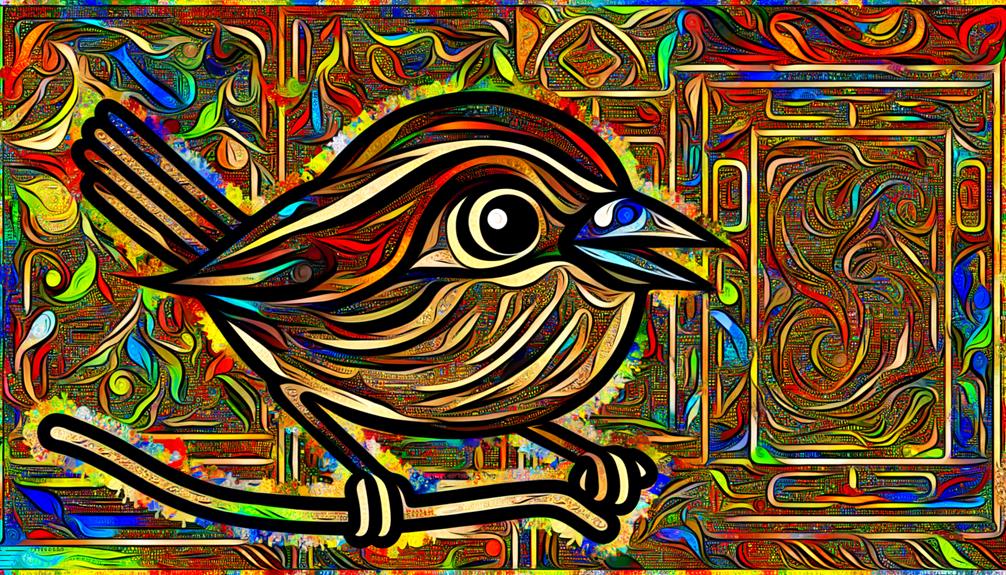What Does the Phrase “He Was as Hot and Lecherous as a Sparrow” Mean?
The phrase 'he was as hot and lecherous as a sparrow' originates from medieval literature, famously used by Chaucer. Sparrows symbolize unrestrained sexual desire and lasciviousness due to their prolific mating habits.
Medieval authors harnessed this symbolism to critique human morality and societal norms. By likening a person to a sparrow, the phrase underlines their unabashed carnal impulses.
Understanding this metaphor reveals deeper insights into medieval perspectives on human nature and societal pretensions. The phrase's enduring relevance in literature and modern discourse continues to shed light on the complexities of human desires.
There's much more to discover about this compelling metaphor.

Key Takeaways
- The phrase 'He was as hot and lecherous as a sparrow' symbolizes unrestrained lust and sexual activity.
- Originating from medieval literature, sparrows were linked to lasciviousness due to their mating habits.
- Chaucer used this phrase in 'The Canterbury Tales' to depict characters' carnal desires.
- The phrase critiques societal norms and exposes the complexity of human desires and morality.
- It remains relevant today, describing flirtatious behavior and uninhibited passion.
Origins of the Phrase

The phrase 'He was as hot and lecherous as a sparrow' finds its origins in medieval literature, where sparrows were often symbolically associated with lasciviousness and fervent sexual activity. Medieval authors imbued these small birds with connotations of unbridled desire, reflecting societal views on morality and sexuality.
The sparrow's prolific mating habits made it a fitting metaphor for untamed lust. Such literary devices allowed writers to critique or satirize human behaviors under the guise of animal symbolism. This association wasn't random but rooted in the observable natural behaviors of sparrows, providing a vivid and relatable image for medieval audiences.
The phrase encapsulates the era's complex interplay between nature, morality, and human vice.
Chaucer's Use in Literature
Chaucer, ever adept at weaving rich symbolism into his narratives, masterfully employed the phrase 'He was as hot and lecherous as a sparrow' to underscore the unabashed carnal desires of his characters in 'The Canterbury Tales.'
This vivid metaphor highlights the unrestrained lust that permeates his tales, particularly in characters such as the Wife of Bath and the Miller. By likening human libido to the natural, instinctual behaviors of sparrows, Chaucer renders a strikingly raw depiction of medieval sexuality.
His choice of language not only reflects the mores of his time but also serves to critique the superficial piety often displayed by society. Through this phrase, Chaucer skillfully exposes the hypocrisy and complexity of human desires.
Symbolism of the Sparrow

In medieval literature, sparrows often symbolize insatiable lust and unrestrained passion, mirroring the unabashed desires Chaucer's characters frequently exhibit.
The sparrow's fervent mating habits serve as a potent metaphor for human lasciviousness, embodying the themes of eroticism pervasive in Chaucer's works.
By using the sparrow, authors deftly illustrate the compelling nature of carnal desires that drive human behavior.
This symbolism isn't arbitrary; it draws on the observable, natural world to provide a vivid parallel to human impulses.
Consequently, the sparrow becomes a literary device that both enriches the narrative and deepens the reader's understanding of character motivations.
Such representations invite readers to explore the complexities of desire and morality within the human experience.
Historical Context
Delving into the historical context, one uncovers the intricate tapestry of medieval societal norms and values that shaped Chaucer's vivid character portrayals. During the Middle Ages, societal structures were rigid, with clear distinctions between classes and roles.
The Church wielded immense influence, dictating moral conduct and societal expectations. Chaucer, writing in the late 14th century, used his characters to reflect and critique these norms. The portrayal of a character as 'hot and lecherous' signifies not just personal traits but also broader societal attitudes towards sin, lust, and morality.
Understanding this context allows modern readers to grasp the nuances of Chaucer's work, revealing a society grappling with human desires and ecclesiastical morality within its rigid hierarchical framework.
Cultural Interpretations

Modern readers often grapple with the rich tapestry of cultural interpretations that Chaucer's phrase 'hot and lecherous as a sparrow' evokes, revealing layers of meaning shaped by diverse historical and societal lenses.
In medieval Europe, sparrows were commonly associated with promiscuity and lack of restraint, reflecting societal anxieties about moral conduct. This metaphor extends beyond mere animal behavior, encapsulating broader themes of human desire and moral judgment.
Additionally, various cultures imbue sparrows with distinct symbolic resonances; for instance, in some Eastern traditions, they represent simplicity and communal living, contrasting sharply with Chaucer's depiction.
Therefore, analyzing this phrase necessitates an understanding of multifaceted cultural connotations, providing a window into the complex interplay between literature, symbolism, and societal norms.
Literary Analysis
In examining the literary dimensions, the character's portrayal as 'hot and lecherous as a sparrow' serves as a potent symbol reflecting primal desires and unchecked impulses.
The sparrow imagery enriches the text, imbuing it with layers of meaning that underscore the character's untamed and promiscuous nature.
This vivid metaphor not only enhances our understanding of the character's motivations but also elevates the narrative's thematic complexity.
Character Symbolism Explored
Character symbolism in the phrase 'He was as hot and lecherous as a sparrow' draws on avian imagery to underscore themes of lust and fleeting passion. By likening the character to a sparrow, the author effectively conveys an impression of insatiable desire and transient encounters.
Sparrows, known for their ubiquity and prolific mating habits, become apt symbols for a character driven by momentary pleasures rather than enduring commitments. This avian metaphor doesn't just paint a picture of the character's behavior but also subtly critiques it, suggesting a lack of depth and substance.
The sparrow's restless, ceaseless nature mirrors the character's own moral and emotional vacuity, offering readers a nuanced understanding of his superficiality and impermanence.
Sparrow Imagery Significance
Frequently, authors employ sparrow imagery to encapsulate themes of ephemerality and insatiable desire, leveraging the bird's natural characteristics to enrich the narrative's symbolic depth.
Sparrows, often seen flitting restlessly from place to place, embody a sense of fleeting existence and fervent, albeit transient, passion. This imagery conveys a duality of innocence and primal instinct, reflecting characters' inner turmoil and uncontrollable impulses.
By invoking the sparrow, writers underscore the paradox of life's brevity juxtaposed with the intensity of momentary desires. The sparrow's ubiquitous presence yet unnoticed existence mirrors human tendencies toward overlooked passions and unnoticed fervor.
In this way, the sparrow becomes a potent symbol, encapsulating complex emotional states and thematic undercurrents within literary works.
Comparisons to Other Similes

When comparing the simile 'as hot and lecherous as a sparrow' to other animalistic desire imagery, one observes a rich tapestry of cultural variations that evoke distinct emotional impacts.
Different similes often draw from region-specific fauna, shaping unique connotations and intensities of desire and passion.
Analyzing these comparisons illuminates how language reflects and shapes cultural attitudes towards human emotions and behaviors.
Animalistic Desire Imagery
Similes comparing human desire to animalistic traits, such as 'hot and lecherous as a sparrow,' evoke a primal, instinctual imagery that resonates deeply with the reader's understanding of raw, unrestrained passion. These comparisons harness the visceral energy embedded within the animal kingdom, creating vivid and memorable imagery.
Consider the following:
- 'Hungry as a wolf' conveys an insatiable, almost predatory desire, highlighting the intensity of the emotion.
- 'Fierce as a lion' suggests a powerful, dominating passion, underscoring both strength and ferocity.
- 'Restless as a cat in heat' vividly illustrates an uncontrollable, urgent need, emphasizing a biological drive.
Such similes effectively tap into universal, archetypal symbols, making the described emotions more palpable and immediate for the reader.
Cultural Simile Variations
Across cultures, similes often diverge in their metaphorical associations, reflecting unique societal values and natural environments.
For instance, in English, the phrase 'as busy as a bee' highlights industriousness, drawing from the observable behavior of bees. Conversely, in Japanese culture, the equivalent metaphor might involve the cicada, an insect known for its relentless activity.
Similarly, the simile 'as sly as a fox' in Western cultures underscores cunning, while in Chinese culture, the tiger epitomizes both strength and strategic intelligence.
These variations illustrate how local fauna influence metaphorical language, shaping cultural perceptions and values. By examining these divergent similes, one gains insight into the nuanced interplay between language, environment, and cultural identity, revealing the richness of human expression.
Emotional Impact Comparison
How do varying similes evoke distinct emotional responses and shape our perceptions of human behavior across different cultures?
Similes serve as powerful linguistic tools, influencing our emotional and cognitive reactions. Consider the following:
- 'As hot and lecherous as a sparrow' invokes an image of unrestrained desire, often considered negative and morally questionable.
- 'As loyal as a dog' conjures feelings of warmth and trust, underscoring fidelity and companionship.
- 'As cunning as a fox' suggests intelligence and strategic thinking, though sometimes with a hint of deceit.
These similes encapsulate cultural values and norms, guiding how behaviors are interpreted and judged.
Through comparison, one can discern how language shapes societal attitudes, offering insight into the diverse moral landscapes that define human interaction.
Modern Usage and Relevance
Today's vernacular often sees the phrase 'as fiery and lustful as a sparrow' utilized to describe someone's unabashedly flirtatious or promiscuous behavior, reflecting its enduring relevance in contemporary discourse.
This idiom encapsulates a vivid image of uninhibited desire and impulsiveness. In modern contexts, it's employed both humorously and critically, depending on the speaker's intent. The metaphor's potency lies in its ability to succinctly convey character judgments, making it a valuable rhetorical tool. Additionally, its colorful nature ensures it remains memorable and impactful.
Its usage spans casual conversations and literary works alike, demonstrating its versatility. Therefore, this phrase continues to resonate, enriching the lexicon with a blend of wit and incisiveness.
Conclusion
Chaucer's phrase 'as hot and lecherous as a sparrow' endures through its vivid imagery and cultural resonance.
Curiously, sparrows can mate up to 20 times an hour, a statistic that underscores the aptness of Chaucer's simile.
This evocative comparison bridges medieval and modern sensibilities, highlighting timeless human behaviors.
By examining its origins and usage, we appreciate the depth of Chaucer's work and the phrase's lasting relevance in literature and beyond.






